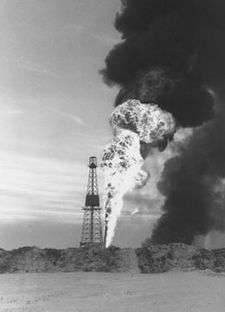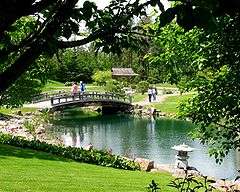Devon, Alberta
Devon is a town in the province of Alberta, Canada, situated 26 km (16 mi) southwest of Edmonton, the provincial capital, and located along the banks of the North Saskatchewan River.
Devon | |
|---|---|
Town | |
| Town of Devon | |
 Flag | |
 Devon Location of Devon in Alberta | |
| Coordinates: 53°21′48″N 113°43′56″W | |
| Country | Canada |
| Province | Alberta |
| Region | Edmonton Metropolitan Region |
| Census division | 11 |
| Municipal district | Leduc County |
| Adjacent municipal district | Parkland County |
| Incorporated[1] | |
| • Village | December 31, 1949 |
| • Town | February 24, 1950 |
| Named for | Devonian Period |
| Government | |
| • Mayor | Ray Ralph |
| • Governing body | Devon Town Council |
| • MLA | Mark Smith |
| Area (2016)[3] | |
| • Land | 14.3 km2 (5.5 sq mi) |
| Elevation | 709 m (2,326 ft) |
| Population (2016)[3] | |
| • Total | 6,578 |
| • Density | 460.2/km2 (1,192/sq mi) |
| Time zone | UTC−07:00 (MST) |
| • Summer (DST) | UTC−06:00 (MDT) |
| Forward sortation area | T9G |
| Area code(s) | 780 |
| Highways | 19, 60 |
| Waterways | North Saskatchewan River |
| Website | devon |
History
Devon owes its existence to one of the largest oil discoveries in the world. On February 13, 1947 the Imperial Leduc No. 1 well struck oil, and the new town of Devon was constructed shortly thereafter by Imperial Oil to accommodate its workers. The company was determined that the town would be well-planned, and Devon holds the distinction of being the first Canadian community to be approved by a regional planning commission. The oil industry remains a major player in the town's business sector, though the economy has diversified to include tourism, manufacturing, and research.
Devon is named after the Devonian formation (the strata tapped in the Leduc No. 1 oil well), which in turn is named for the county of Devon in England.
Climate
Devon boasts a warm-summer humid continental climate (Köppen: Dfb), slightly cooler than Edmonton.[5] On average at 3.6 days a year the temperature is above 30 °C (86 °F) days above 35 °C (95 °F) do not always occur, but on average four years in a decade. Days with temperatures below −30 °C (−22 °F) occur every year on average 8.8 nights. In about 58.4% of the days of a year the temperature can reach a value less than or equal to the freezing temperature. Frost free will go from the beginning of June until the first week of September, usually. It corresponds in average to 96 days.[6]
| Climate data for Devon (Devonian Botanic Garden), elevation: 670.6 m (2,200 ft), 1981-2010 normals, extremes 1973-2007 | |||||||||||||
|---|---|---|---|---|---|---|---|---|---|---|---|---|---|
| Month | Jan | Feb | Mar | Apr | May | Jun | Jul | Aug | Sep | Oct | Nov | Dec | Year |
| Record high °C (°F) | 13.0 (55.4) |
16.0 (60.8) |
24.0 (75.2) |
30.6 (87.1) |
33.5 (92.3) |
35.0 (95.0) |
35.5 (95.9) |
35.0 (95.0) |
35.0 (95.0) |
30.5 (86.9) |
20.0 (68.0) |
15.0 (59.0) |
35.5 (95.9) |
| Average high °C (°F) | −5.4 (22.3) |
−2.4 (27.7) |
2.9 (37.2) |
11.8 (53.2) |
18.1 (64.6) |
21.3 (70.3) |
23.5 (74.3) |
22.4 (72.3) |
17.2 (63.0) |
10.5 (50.9) |
0.0 (32.0) |
−4.1 (24.6) |
9.7 (49.4) |
| Daily mean °C (°F) | −11.1 (12.0) |
−8.6 (16.5) |
−3.3 (26.1) |
4.7 (40.5) |
10.4 (50.7) |
14.1 (57.4) |
16.4 (61.5) |
15.2 (59.4) |
10.1 (50.2) |
4.2 (39.6) |
−4.9 (23.2) |
−9.7 (14.5) |
3.1 (37.6) |
| Average low °C (°F) | −16.7 (1.9) |
−14.8 (5.4) |
−9.5 (14.9) |
−2.4 (27.7) |
2.7 (36.9) |
6.9 (44.4) |
9.3 (48.7) |
8.0 (46.4) |
2.9 (37.2) |
−2.2 (28.0) |
−9.9 (14.2) |
−15.2 (4.6) |
−3.4 (25.9) |
| Record low °C (°F) | −45.0 (−49.0) |
−45.0 (−49.0) |
−40.0 (−40.0) |
−30.0 (−22.0) |
−10.0 (14.0) |
−2.5 (27.5) |
1.0 (33.8) |
−4.0 (24.8) |
−10.0 (14.0) |
−25.0 (−13.0) |
−35.0 (−31.0) |
−46.0 (−50.8) |
−46.0 (−50.8) |
| Average precipitation mm (inches) | 24.8 (0.98) |
14.3 (0.56) |
22.2 (0.87) |
27.3 (1.07) |
52.3 (2.06) |
84.5 (3.33) |
102.7 (4.04) |
67.0 (2.64) |
49.5 (1.95) |
25.6 (1.01) |
22.5 (0.89) |
15.3 (0.60) |
508 (20) |
| Average rainfall mm (inches) | 1.2 (0.05) |
0.3 (0.01) |
1.5 (0.06) |
16.2 (0.64) |
47.5 (1.87) |
84.5 (3.33) |
102.7 (4.04) |
66.7 (2.63) |
48.6 (1.91) |
14.6 (0.57) |
1.7 (0.07) |
0.7 (0.03) |
386.2 (15.21) |
| Average snowfall cm (inches) | 23.6 (9.3) |
14.1 (5.6) |
20.6 (8.1) |
11.1 (4.4) |
4.8 (1.9) |
0.0 (0.0) |
0.0 (0.0) |
0.3 (0.1) |
0.9 (0.4) |
11.0 (4.3) |
20.8 (8.2) |
14.5 (5.7) |
121.7 (48) |
| Average precipitation days (≥ 0.2 mm) | 9.1 | 6.9 | 7.6 | 7.0 | 10.3 | 14.7 | 15.2 | 12.4 | 10.3 | 7.4 | 8.1 | 7.1 | 116.1 |
| Average rainy days (≥ 0.2 mm) | 0.67 | 0.23 | 1.1 | 4.6 | 10.1 | 14.7 | 15.2 | 12.4 | 10.2 | 5.4 | 1.1 | 0.31 | 76.01 |
| Average snowy days (≥ 0.2 cm) | 8.5 | 6.7 | 6.6 | 2.9 | 0.56 | 0.0 | 0.0 | 0.04 | 0.26 | 2.4 | 7.1 | 6.9 | 41.96 |
| Source: Environment Canada[6] | |||||||||||||
Demographics
In the 2016 Census of Population conducted by Statistics Canada, the Town of Devon recorded a population of 6,578 living in 2,415 of its 2,493 total private dwellings, a 1% change from its 2011 population of 6,515. With a land area of 14.3 km2 (5.5 sq mi), it had a population density of 460.0/km2 (1,191.4/sq mi) in 2016.[3]
The population of the Town of Devon according to its 2014 municipal census is 6,650, a 1.8% change from its 2009 municipal census population of 6,534.[7]
In the 2011 Census, the Town of Devon had a population of 6,510 living in 2,387 of its 2,471 total dwellings, a 4% change from its 2006 adjusted population of 6,261. With a land area of 11.72 km2 (4.53 sq mi), it had a population density of 555.5/km2 (1,438.6/sq mi) in 2011.[8]
Economy
The Town of Devon is a member of the Leduc-Nisku Economic Development Association, an economic development partnership that markets Alberta's International Region[9] in proximity to the Edmonton International Airport.[10]
Amenities
Devon is amply served by schools, community services such as the Devon General Hospital, and recreational facilities. It is 20 km (12 mi) from the Edmonton International Airport, and is close to major rail routes and highways. It is located close to a motor sports park, a bird sanctuary, the University of Alberta Botanic Garden, and a number of other attractions to residents and visitors. Devon and area is popular with cyclists, as it has a good network of paved country roads, as well as unpaved mountain bike trails, and has hosted high level cycling events such as Canada's 2010 National Road Championships.
Schools
- Devon Christian School
- Holy Spirit Catholic School
- John Maland High School
- Riverview Middle School
- Robina Baker Elementary
Miscellaneous
Devon is the sister city to Grimma, Germany. in 2008, a group of students and dignitaries from Devon travelled to Grimma to perform in an international music festival. In 2010, members of the Grimma Jugendblasorchester (Youth Orchestra) travelled to Devon to perform and to tour Alberta.
References
- "Location and History Profile: Town of Devon" (PDF). Alberta Municipal Affairs. October 7, 2016. p. 190. Retrieved October 11, 2016.
- "Municipal Officials Search". Alberta Municipal Affairs. September 22, 2017. Retrieved September 25, 2017.
- "Population and dwelling counts, for Canada, provinces and territories, and census subdivisions (municipalities), 2016 and 2011 censuses – 100% data (Alberta)". Statistics Canada. February 8, 2017. Retrieved February 8, 2017.
- "Alberta Private Sewage Systems 2009 Standard of Practice Handbook: Appendix A.3 Alberta Design Data (A.3.A. Alberta Climate Design Data by Town)" (PDF) (PDF). Safety Codes Council. January 2012. pp. 212–215 (PDF pages 226–229). Retrieved October 8, 2013.
- "Clima Devon: Temperatura, Tempo e Dados climatológicos Devon - Climate-Data.org". pt.climate-data.org. Retrieved 2019-07-16.
- "Edmonton Woodbend (3012230) - 1981 to 2010 Canadian Climate Normals". Environment Canada. Retrieved July 16, 2019.
- "2014 Municipal Census Final Report" (PDF) (PDF). Town of Devon. p. 1. Archived from the original (PDF) on August 12, 2014. Retrieved August 6, 2014.
- "Population and dwelling counts, for Canada, provinces and territories, and census subdivisions (municipalities), 2011 and 2006 censuses (Alberta)". Statistics Canada. 2012-02-08. Retrieved 2012-02-08.
- "About Us". Leduc-Nisku Economic Development Association. Archived from the original on 2012-02-17. Retrieved 2012-06-23.
- "Explore the Region". Leduc-Nisku Economic Development Association. Archived from the original on 2012-04-16. Retrieved 2012-06-23.

